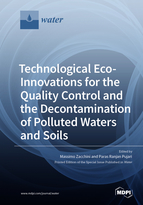Technological Eco-Innovations for the Quality Control and the Decontamination of Polluted Waters and Soils
A special issue of Water (ISSN 2073-4441). This special issue belongs to the section "Wastewater Treatment and Reuse".
Deadline for manuscript submissions: closed (30 June 2019) | Viewed by 45419
Special Issue Editors
Interests: phytoremediation; metal uptake and transport in plants; ecotoxicological assessment; phytomanagement; tissue culture
Special Issues, Collections and Topics in MDPI journals
Special Issue Information
Dear Colleagues,
The impact of industrial development on the environment is often severe and many times dramatically destructive. In these last years, technologies based on a better understanding of natural processes and the discovery of new materials and analytical techniques have been further developed, offering a wide array of innovative solutions to recover critical situations due to the over-exploitation of natural resources. Such technologies represent extraordinary tools for addressing the environmental challenges we are facing worldwide, in order to propose sustainable approaches to the issues related to water and soil quality and the decontamination of polluted environmental matrices. In this regard, the Special Issue will be particularly focused on research papers highlighting a collaboration between European and Indian researchers under the EU–India Research and Innovation Partnership “TECO” project. Apart from that, papers dealing with eco-innovative solutions, carried out both at field and laboratory scale, addressing the issues related to water and soil quality and decontamination, will be welcomed. Special attention will be given to research articles focused on the use of biological organisms to monitor environmental quality and to decontaminate polluted water and soils.
Dr. Massimo Zacchini
Dr. Paras Ranjan Pujari
Guest Editors
Manuscript Submission Information
Manuscripts should be submitted online at www.mdpi.com by registering and logging in to this website. Once you are registered, click here to go to the submission form. Manuscripts can be submitted until the deadline. All submissions that pass pre-check are peer-reviewed. Accepted papers will be published continuously in the journal (as soon as accepted) and will be listed together on the special issue website. Research articles, review articles as well as short communications are invited. For planned papers, a title and short abstract (about 100 words) can be sent to the Editorial Office for announcement on this website.
Submitted manuscripts should not have been published previously, nor be under consideration for publication elsewhere (except conference proceedings papers). All manuscripts are thoroughly refereed through a single-blind peer-review process. A guide for authors and other relevant information for submission of manuscripts is available on the Instructions for Authors page. Water is an international peer-reviewed open access semimonthly journal published by MDPI.
Please visit the Instructions for Authors page before submitting a manuscript. The Article Processing Charge (APC) for publication in this open access journal is 2600 CHF (Swiss Francs). Submitted papers should be well formatted and use good English. Authors may use MDPI's English editing service prior to publication or during author revisions.
Keywords
- bioremediation
- environmental quality
- EU–India partnership
- pollution
- sustainability
- water and soil decontamination







